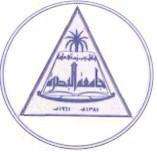University of Basrah
The University of Basrah (Arabic: جامعة البصرة Jāmi'at Al Basrah) is situated in the city of Basra, Iraq. For historic reasons the final -h is retained on Basrah in the name of the university.
 | |
| Motto | وَقُل رَّبِّ زِدْنِي عِلْمًا "And say: My Lord! Increase me in knowledge." (20:114) |
|---|---|
| Type | Public University |
| Established | 1964 |
| President | Prof. Dr. Thamer Ahmad Hamdan Al-Tamimi |
Administrative staff | 4,631 |
| Undergraduates | 99,751 |
| Location | , |
| Campus | Urban |
| Website | www.uobasrah.edu.iq |
Founded in 1964 to meet the needs of southern Iraq, the University of Basrah was at first affiliated with the University of Baghdad, but in 1964 it became an independent body. Today the University consists of fourteen colleges located on three campuses around the city of Basra, with research facilities and student halls of residence (dormitories).
The University awards the degrees of BA, BSc, Higher Diploma, MA, MSc and PhD.
Colleges
The university is composed of 15 colleges:
- College of Medicine
- College of Pharmacy
- College of Dentistry
- College of Veterinary Medicine
- College of Nursing
- College of Engineering
- College of Science
- College of Agriculture
- College of Education
- College of Business and Economics
- College of Law
- College of Arts
- College of Physical Education
- College of Education for Girls
- College of Fine Arts
Centres
The University conducts research through the following research centres:
- Iranian Studies Centre
- Marine Science Centre
- Polymer Studies Centre
- Arabian Gulf Studies Centre
- Basrah Studies Centre
- Date Palm Research Centre
- Educational Counselling Centre
- Resources Centre
- Teaching Methods Development Centre
- Living Languages Centre
- Computer Centre
- Continuing Educational Centre
There is also the Desalination Unit (affiliated with the College of Engineering), the Natural History Museum, the Haemoglobinopathy Unit, the Internet Resources Centre, the Central Library, and a Publishing house.
Campuses
The University of Basrah consists of three campuses, they are as follows:
- Northern Campus of Qarmat Ali contains the colleges of Pharmacy, Veterinary Medicine, Engineering, Science, Education, Agriculture and Physical Education.
- Southern Campus of Bab Al Zubayer contains the colleges of Business and Economics, Law, Arts, Historical Studies, Fine Arts.
- College of Medicine Campus contains the College of Medicine and the Teaching Hospital.
- College of Dentistry Campus contains the College of Dentistry.
Presidents
- Dr. Abdel Hadi Mahbooba (01/04/1964 to 24/10/1968)
- Dr. Sadeq Al-Khayyat (from 25/10/1968 to 03/10/1969)
- Dr. Saad Abdul Baqi Al Rawi(from 04/10/1969 to 31/12/1969)
- Dr. Khalil Hamid Al Talib(from 01/01/1970 to 04/04/1970)
- Dr. Nizar Nadheef Al-Shawi (from 05/04/1970 to 05/09/1975)
- Dr. Yousef Abdul Illah Khashab (from 05/09/1975 to 05/12/1984)
- Dr. Majeed Mohammed Saeed (from 06/12/1984 to 21/03/1985)
- Dr. Dakhil Hassan Jrew (from 21/03/1985 to 05/02/1993)
- Dr. Akram Mohammed Sobhi (from 06/02/1993 to 30/08/2001)
- Dr. Mohammed Abdul Al Al Nuaimi (from 01/09/2001 to 09/04/2003)
- Dr. Salman Dawood Salman (from 01/05/2003 to 11/09/2005)
- Dr. As'ad Saleem Abdulqadir (from 01/07/2004 to 1/09/2004)
- Dr. Ali Abbass Alwan (from 11/09/2005 to 29/10/2009)
- Dr. Salih Ismail Najim (from 01/11/2009 until 26/6/2012)
- Prof. Thamer Ahmad Hamdan Al-Tamimi (from 27/6/2012 until now)
External links
- University of Basrah website (in Arabic and English)